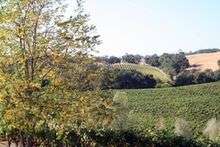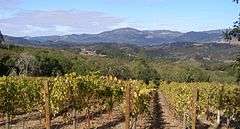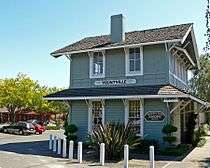Wine Country (California)


The Wine Country is an area of Northern California in the United States known worldwide as a premium wine-growing region.[1] Viticulture and wine-making have been practiced in the region since the mid-19th century. There are over 400 wineries in the area north of San Francisco,[2] mostly located in the area's valleys, including Napa Valley in Napa County, and the Sonoma Valley, Alexander Valley, Dry Creek Valley, Bennett Valley, and Russian River Valley in Sonoma County. Wine grapes are also grown at higher elevations, such as Atlas Peak and Mount Veeder AVAs.[3] The region is defined not only by its viticulture, but also its ecology, geology, architecture,[4] cuisine,[5] and culture.[6] The majority of the grape harvest, by both area and value, derives from Sonoma County.[7]
Cities and towns associated with the Wine Country include Santa Rosa, Healdsburg, Sonoma, Kenwood, Petaluma, Sebastopol, Guerneville, Windsor, Geyserville, and Cloverdale in Sonoma County; Napa, Yountville, Rutherford, St. Helena and Calistoga in Napa County; and Hopland and Ukiah in Mendocino County.
Appellations

Wine Country is generally regarded as the combined counties of Napa, Sonoma, Mendocino, and Lake. These counties contain the following American Viticultural Areas (AVAs):[8]
- in Sonoma County: Alexander Valley, Bennett Valley, Chalk Hill, Dry Creek Valley, Green Valley of Russian River Valley, Knight's Valley, Los Carneros, Northern Sonoma, Rockpile, Russian River Valley, Sonoma Coast, Sonoma Mountain, and Sonoma Valley.
- in Napa County: Atlas Peak, Los Carneros, Mount Veeder, Napa Valley, Oakville, Rutherford, Saint Helena, Calistoga, Stags Leap District, and Yountville.
- in Mendocino County: Anderson Valley, Covelo, Mendocino, and Potter Valley.
- in Lake County: Clear Lake, Guenoc Valley, High Valley, and Red Hills Lake County.
The six-county North Coast AVA overlaps with the Wine Country as defined here. In addition, the names of the counties themselves are legal for use as appellation names.[9]
History

The earliest prehistory of the Wine Country involves habitation by several Native American tribes from approximately 8000 BC.[10] The principal tribes living in this region included the Pomo, Coast Miwok, Wappo and Patwin, whose early peoples practiced certain forms of agriculture, but probably not involving the cultivation of grapes. During the Mexican Colonial period and after, European settlers brought in more intensive agriculture to the Wine Country, including growing grapes and wine production. Some of the historical events that led to the establishment of California as a state transpired in the Wine Country. In particular, the town of Sonoma, is known as the birthplace of American California. Agoston Haraszthy is credited with being one of the forefathers of the California wine industry in Sonoma by his planting of grapes in the lower Arroyo Seco Creek watershed of Sonoma County.[11]
Ecology

A diversity of aquatic and terrestrial organisms populate the Wine Country and its riparian zones. Winter-run Chinook salmon (Oncorhynchus tsawytscha), Delta smelt (Hypomesus transpacificus) and steelhead (Oncorhynchus mykiss) are the most prominent fishes. Researchers have studied anadromous fish-movements extensively in Sonoma Creek and in the Napa River as well as in the Laguna de Santa Rosa - not only in the mainstems, but in many of the tributaries. These investigations have demonstrated a historical decline in spawning and habitat value for these species, primarily due to sedimentation[12] and secondarily to removal of riparian vegetation since the 19th century.
A variety of salamanders, snakes and frogs are also present in the Wine Country. The federally listed as threatened California red-legged frog is present in the northern reach draining the south slopes of Annadel State Park.[13] Several endangered species (mostly associated with the Napa Sonoma Marsh) present include Ridgway's rail (Rallus obsoletus), California black rail (Laterallus jamaicensis), California brown pelican (Pelicanus occudentalis), California freshwater shrimp (Syncaris pacifica), salt marsh harvest mouse (Reithrodontomys raviventris ), Suisun shrew (Sorex ornatus sinuosus), Sacramento splittail (Pogonichtys macrolepidotus). The above are endangered species with the exception of the splittail, steelhead and black rail, which are federally designated as threatened.[14]
Upland ecosystems drained include mixed California oak woodland, chaparral and savannah woodland.[15] In these upland reaches one finds plentiful black-tailed deer, coyote, skunk, raccoon, opossum, wild turkey, turkey vulture, red-tailed hawk and occasionally bobcat and mountain lion. Prominent higher elevation trees include: Coast live oak, Garry oak, Pacific madrone, California buckeye, Douglas fir, whereas valley oak is prevalent on the Wine Country valley floors.[16]
Tourism

The Wine Country has undergone a boom in tourism. In 1975 there were only 25 Napa Valley wineries;[17] today there are well over 400 wineries in Napa and Sonoma Counties.[2] Tourists come to the region not only for wine tasting, but also for hiking, bicycling, hot air ballooning, and historic sites, as well as the extensive culinary choices. Numerous notable chefs and restaurateurs are present in the Wine Country, including Thomas Keller, John Ash, and Sondra Bernstein.[18] Besides the obvious winery attractions, the Wine Country is known for the Sonoma County coastline along the Pacific Ocean, the Russian River valley, redwoods, hot spring baths, petrified forests and other natural areas.
The Wine Country tourism boom has its downside, exemplified by traffic congestion on State Route 29, particularly on summer weekends, when the number of tourists often exceeds the carrying capacity of the road. The Napa Valley is also experiencing pressures for increased urbanization and roadway upgrading.[19]
See also
References
- ↑ Elkjer, Thom (2002). Fodor's Escape to the Wine Country: California's Napa, Sonoma, and Mendocino. Fodor's. ISBN 978-0-679-00918-4.
- 1 2 "Fodor's California Wine Country Online". 2006.
- ↑ Appelation America.com
- ↑ Whitesides, Mary (2004). Wine Country: Architecture and Interiors. Layton, Utah: Gibbs Smith.
- ↑ Michael Chiarello, Michael Chiarello's Casual Cooking: Wine Country Recipes for Family and Friends, Chronicle Books, San Francisco, California.
- ↑ Molly Chappellet, Gardens of the Wine Country, Chronicle Books, San Francisco, California.
- ↑ Sonoma County Indicators: 2007
- ↑ Code of Federal Regulations, Title 27, Part 9: American Viticultural Areas.
- ↑ Code of Federal Regulations, Title 27, Section 4.25(a).
- ↑ Stewart, Suzanne B., Time before Time: Prehistory and Archaeology in the Lake Sonoma Area. Sacramento, CA: U.S. Army Corps of Engineers, 1985.
- ↑ Charles Sullivan, Zinfandel: A History of a Grape and Its Wine, Berkeley and Los Angeles, California: University of California Press, 2003.
- ↑ Sonoma Creek Watershed Limiting Factors Analysis, Sonoma Ecology Center, with support from the U.S. Army Corps of Engineers, December 2004.
- ↑ San Francisco Bay Area Conservancy Program Fifth Year Report pg 19
- ↑ Baylands Ecosystem Habitat Goals
- ↑ California's woodlands
- ↑ Wildlife:The Importance of Hardwood Habitat for Wildlife in California, Forest Service, U.S. Department of Agriculture, 1987
- ↑ http://www.winecountrytourshuttle.com/napa_valley_wine_tours.htm
- ↑ Bernstein, Sondra (2004). The Girl & the Fig Cookbook: More than 100 Recipes from the Acclaimed California Wine Country Restaurant. ISBN 0-7432-5521-6.
- ↑ Trancas Road/California State Route 29 Intersection Improvements
External links
| Wikivoyage has a travel guide for California Wine Country. |
| Wikimedia Commons has media related to Wine Country. |
- Wine Country at DMOZ
